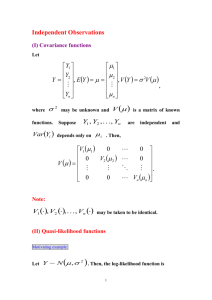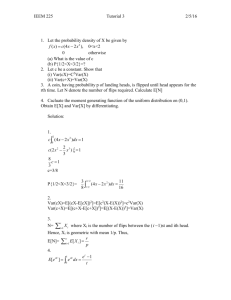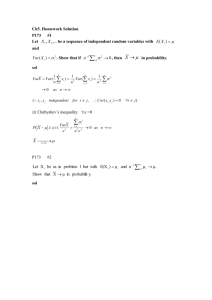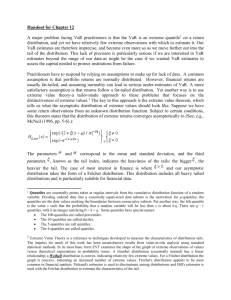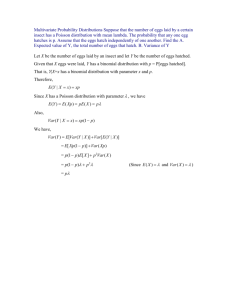Solutions
advertisement
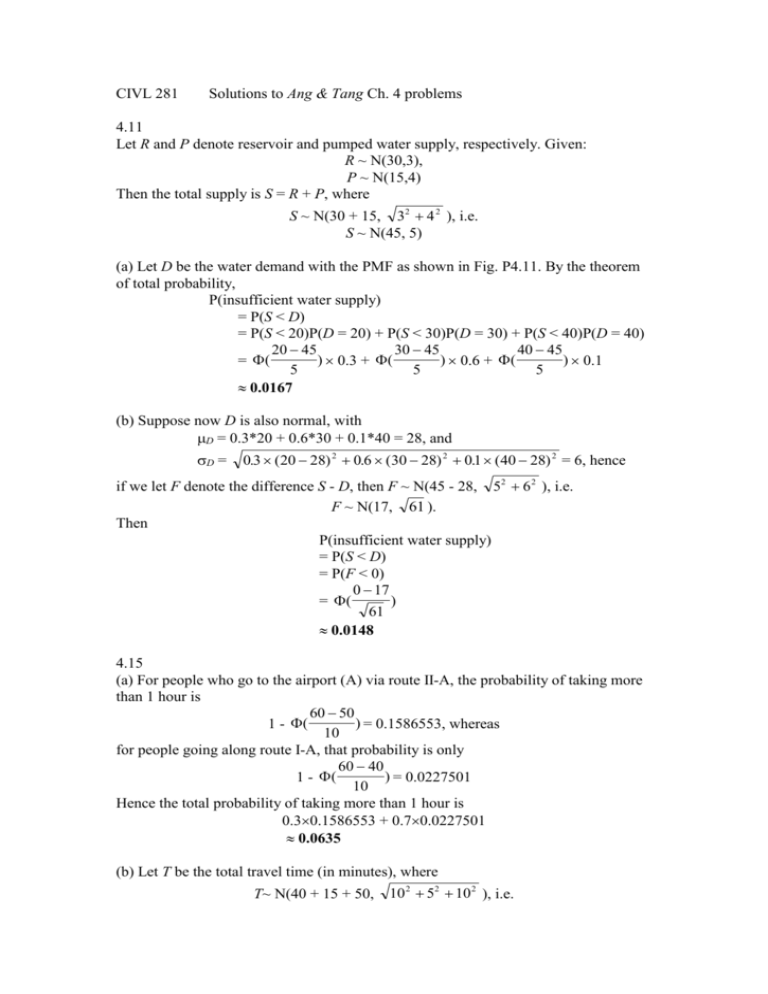
CIVL 281 Solutions to Ang & Tang Ch. 4 problems 4.11 Let R and P denote reservoir and pumped water supply, respectively. Given: R ~ N(30,3), P ~ N(15,4) Then the total supply is S = R + P, where S ~ N(30 + 15, 32 4 2 ), i.e. S ~ N(45, 5) (a) Let D be the water demand with the PMF as shown in Fig. P4.11. By the theorem of total probability, P(insufficient water supply) = P(S < D) = P(S < 20)P(D = 20) + P(S < 30)P(D = 30) + P(S < 40)P(D = 40) 20 45 30 45 40 45 ) 0.3 + ( ) 0.6 + ( ) 0.1 = ( 5 5 5 0.0167 (b) Suppose now D is also normal, with D = 0.3*20 + 0.6*30 + 0.1*40 = 28, and D = 0.3 (20 28) 2 0.6 (30 28) 2 01 . (40 28) 2 = 6, hence if we let F denote the difference S - D, then F ~ N(45 - 28, 52 6 2 ), i.e. F ~ N(17, 61 ). Then P(insufficient water supply) = P(S < D) = P(F < 0) 0 17 ) = ( 61 0.0148 4.15 (a) For people who go to the airport (A) via route II-A, the probability of taking more than 1 hour is 60 50 ) = 0.1586553, whereas 1 - ( 10 for people going along route I-A, that probability is only 60 40 ) = 0.0227501 1 - ( 10 Hence the total probability of taking more than 1 hour is 0.30.1586553 + 0.70.0227501 0.0635 (b) Let T be the total travel time (in minutes), where T~ N(40 + 15 + 50, 10 2 52 10 2 ), i.e. T ~ N(105, 15). Hence 120 105 ) = (1) 0.841 P(T < 120) = ( 15 Now let U be the total travel time for two round trips, we have U ~ N(105 + 105, 152 152 ), i.e. U ~ N(210, 15 2 ). Hence the required probability is 240 210 P(U < 240) = ( ) 0.921 15 2 which is different from P(T < 120). This is expected since not everything inside got scaled by a factor of 2 (namely, the standard deviation only went up by a factor of 2) (c) Let R = minutes spent after 7:50am for the friend to arrive at the airport; R ~ N(50,10). Given fact: R > 60, and we want P(R < 70 | R > 60) P( R 70 and R 60) = P( R 60) 70 50 60 50 ( ) ( ) 10 10 = 60 50 1 ( ) 10 0.857 4.19 (a) No, since A, B, D all depend on R, they depend on each other, and are therefore not s.i. (b) T=A+B+D = 0.38R + 0.7, hence E(T) = 0.38E(R) + 0.7 = 0.3815 + 0.7 = 6.4; Var(T) = 0.382 Var(R) = 0.38222 0.578 T is normally distributed. (c) S = 30 + T - I - M - E, hence E(S) = 30 +E(T) - E(I) - E(M) - E(E) = 30 + 6.4 - 1.5 - 1 - 2.5 = 31.4; Var(S) = Vat(T) + Var(I) + Var(M) + Var(E) = 0.5776 + 0.09 + 0.01 + 0.16 0.8376 S is normally distributed. (d) P(S > 30) = 1 - P(S < 30) = 1 - ( 30 314 . ) 0.8376 0.937 4.23 (a) Given parameters: Median xm = 4, x = 0.2 x = ln(xm) = ln 4; x x = 0.2; also Median fm = 0.15, F = 0.1 F = ln(fm) = ln 0.15; F F = 0.1 Note that F is the fraction of pollutant remaining untreated, i.e. Y F , hence X Y = FX being the product of log-normal random variables, it must also be log-normal, with parameters Y = F + X = ln 0.15 + ln 4 - 0.51 Y F2 X2 01 . 2 0.2 2 0.22 (b) P(Y > 1) = 1 - P(Y < 1) ln 1 Y ) = 1 - ( Y ln 1 0.51 ) = 1 - ( 0.22 = 1 - (2.28448) 0.0112 (c) On a B(ad day), the median of X becomes 5 instead of 4, while other parameters remain the same, hence the parameters of Y change to Y = F + X = ln 0.15 + ln 5; Y 0.22 (as before) Hence the probability of exceedence, given a bad day, is P(Y > 1 | B) ln 1 (ln 5 ln 015 . ) ) = 1 - ( 0.22 = 1 - (1.287) 0.099 Hence on any given day (Good or Bad), P(exceedence) = P(Y > 1 | G)P(G) + P(Y > 1 | B)P(B) = 0.01120.9 + 0.0990.1 0.020 4.26 Given: Arrival of planes: Poisson, with mean rate A = 20 (planes/hr); Departure of planes: Poisson, with mean rate D = 30 (planes/hr) (a) Let X = total number of arrivals and/or departures, whose mean occurrence rate is X = A + D = 50 planes/hr, hence, over a 6-minute period, i.e. t = (6/60) hr = 0.1 hr, = t = 500.1 = 5, hence e 2 P(X = 2 | t = 0.1) = 0.084 2! (b) (i) Let Ni be the number of passengers on the i-th plane that arrived, and T be the total number of them in the last hour. Clearly, T = N1 + N2 + … + N25, hence E(T) = E(N1) + E(N2) + … + E(N25) = 100 + 100 + … +100 = 25100 = 2500, while Var(T) = Var(N1) + Var(N2) + … + Var(N25) (s.i. assumed) = 25(0.4100)2 = 40000 (ii) Assuming s.i. between Ni , and that their distributions are well-behaved functions that allow application of the central limit theorem, we conclude that T is approximately normal (with T = 2500 and T = 200), hence P(T > 3000) = 1 - P(T < 3000) 3000 2500 ) = 1 - ( 200 1 - 0.99379032 0.0062 4.32 (a) Given: IA = 1000 IA = IA IA = 0.11000 = 100 IB = 2000 IB = IB IB = 0.12000 = 200 The noise intensity at C, IA IB IC = = 0.01 IA + 0.0025 IB, 2 (9 1) (19 1) 2 hence E(IC) = 0.01 E(IA) + 0.0025 E(IB) = 0.011000 + 0.00252000 = 15 units, while Var(IC) = 0.012 Var(IA) + 0.00252 Var(IB) = 1.25 (sq. units) (b) In number of decibels, the intensity at C is DC = 40 ln(2IC), where IC is a RV with mean = 15 and variance = 1.25. We can approximate the mean and variance of DC by recalling the formulas (for Y = g(X)) E(Y) g(X), 2 Var(Y) g ' ( X ) Var ( X ) therefore, since E(IC) = 15, and d d 40 ( DC ) (40 ln(2 I C )) , dI C dI C IC we have E(DC) 40 ln(215) 136.0, and 2 40 Var(DC) 125 . 8.89 15



